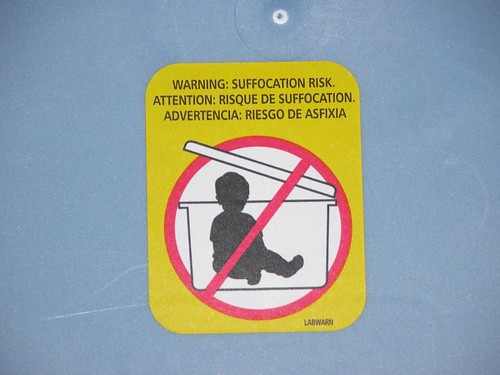Typically, risk and ambiguity are things that we try to eliminate from our lives. We make our kids wear helmets when they ride their bikes to decrease the risk of head injury. We're given detailed instructions for how to put together complex appliances or pieces of furniture. And, we make sure plastic storage tubs come with explicit warnings like this, to make sure there isn't any question about the inappropriateness of storing children in such containers. Clearly, I'm being a bit facetious here, but the point is that most of us operate from the assumption that the more we can get rid of risk and ambiguity, the better things will go.
While this is true in some parts of our lives, there are some aspects of our experience where moderate degrees of risk and ambiguity actually improve our behavior and performance. Take the design of roads as an example, as reported here and in much more depth in Tom Vanderbilt's interesting book, Traffic: Why we drive the way we do (and what it says about us). The essence of the argument is that drivers are more cautious, more aware, more considerate, and ultimately more safe when roads are stripped of the features we've long believed make them safer (e.g. signs, dividing lines, large distances between roads and sidewalks, and width to name a few). Road designers (largely in Europe, those West Palm Beach, Florida has seemed to catch on) have realized this and started to design roads that are just risky enough that drivers have to slow down and drive skillfully (which most of us can do when we are actually thinking about it--the problems occur when we are lulled into autopilot by the "safety" of the road). It is an incredibly interesting approach and one that will likely revolutionize urban planning and road design in the future (it is a philosophy first pioneered by a Dutch traffic engineer--Hans Monderman)
Risk is a theme I've taken on in this blog a number of times. I think it has tremendous implications for learning. My current wondering has to do with what it might mean for higher education institutions to embrace risk and ambiguity in calculated ways. College campuses are full of the equivalent of road signs and safety features, meant to "protect" students and get them where they're going in a metaphorical sense (be it a job, graduation, or just becoming an engaged citizen). We have advisement centers and student support services that notify students that they are on academic warning, reminders about graduation deadlines, policies preventing students from enrolling in more than a specified number of credit hours, and course catalogs that attempt to remove ambiguity by clarifying and outlining hundreds of policies and processes relevant to a particular campus. I'm not ready to say that we should think about getting rid of any or all of those things. However, I wonder if in our effort to protect students through our various policies, support services, and "clarifications" we might actually be causing more problems than we're solving. And, are there "risks" that we might allow to become more visible and instructive so students approach their experience with a bit more caution and concern than they might otherwise?
A quick example--the course syllabus. This great column from Inside Higher Ed (you really should read it, if nothing else, you'll laugh) illuminates the tension instructors face between including so much information that the document becomes laughably long and painfully detailed, and failing to outline the course w/ enough clarity so as to avoid "scandals" that arise when students question policies or procedures. There is an inherent risk in a faculty member having a thin syllabus. If the expectations for the course, course policies, and schedule aren't made unambiguous, students may not learn what they need to, we may have an argument with them about absences, or they may not know what to do in the event there is a Tsunami and they aren't able to get to campus for class. But, when a course is so structured that the syllabus comes to be viewed as a recipe, that if followed leads to learning, we're in trouble. From my own experience, I can say that when the syllabus outlined exactly what I had to do to earn my "A," I did that and nothing more. Typically, the course became a hoop jumping exercise. It was clear and safe, but I didn't learn much. In contrast, I have had a few classes where ambiguity reigned supreme. Initially, it was very frustrating for me as a learner because I wanted to know what to do, when to do it, and how to report back that I had done it. But, the ironic thing is that the ambiguity increased risk and often nudged me to do much more and better work than I would have otherwise. I don't know that this type of course design is a universal solution; however, designing for learner autonomy can lead to great motivation for some populations of students, particularly high-achieving or self-directed students (see Dan Pink's book Drive for a great discussion of this idea).
Of course, campuses must still be physically safe spaces and be structured in ways that allow students to feel comfortable enough that they aren't perpetually thinking about leaving; however, a little risk might go a long way in improving overall outcomes.

No comments:
Post a Comment